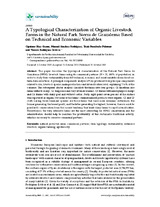A Typological Characterization of Organic Livestock Farms in the Natural Park Sierra de Grazalema Based on Technical and Economic Variables
Autor
Díaz Gaona, Cipriano
Sánchez Rodríguez, M.
Rucabado-Palomar, Thais
Rodríguez-Estévez, V.
Editor
MDPIFecha
2019Materia
Natural protected areasCommunal pastures
Farm typology
Sustainability
Extensive livestock
Organic farming
Agroforestry
METS:
Mostrar el registro METSPREMIS:
Mostrar el registro PREMISMetadatos
Mostrar el registro completo del ítemResumen
This paper describes the typological characterization of the Natural Park Sierra de Grazalema (NPSG) livestock farms using its communal pastures (N = 23, 100% of population) in order to study their sustainability from 160 technical, economic and social variables (from direct on-farm data collection). A principal components analysis (PCA) produced four principal components related to size, livestock species, main productions and intensification level, explaining 73.6% of the variance. The subsequent cluster analysis classified the farms into four groups: C1 (medium size farms without sheep), C2 (large size and very extensive farms), C3 (farms with multipurpose sheep) and C4 (farms with dairy goat and without cattle). Forty-eight-point-seven percent of the surface was registered as organic but none of the farms’ commercialized products were organic. C2 and C3 (both having three ruminant species) are those farms that have more economic differences, the former generating the lowest profit, and the latter generating the highest; however, there is a risk to grasslands conservation from the current tendency that leads dairy farms to rapid intensification. Nevertheless, the very extensive farms are the most interesting for NPSG conservation and the administration should help to maintain the profitability of this sustainable traditional activity, which is necessary to conserve communal pastures.

